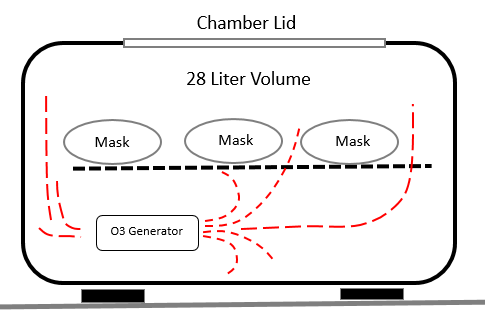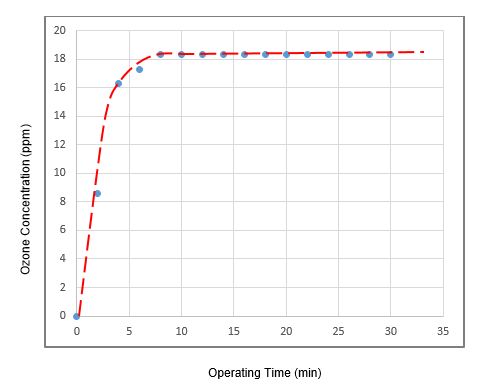Ozone sterilization system for use by families and healthcare workers to disinfect facemasks for multiple reuses.
Background:
The current coronavirus pandemic has sparked global efforts to develop new and creative approaches in addressing shortages of personal protective equipment including respirator masks used by medical workers who treat COVID-19 patients and used by the public to reduce the spread of the virus within the community. While most currently available masks are intended for single-use only, safe and effective disinfection will allow these masks to be reused multiple times.
A portable system based on a non-destructive sterilization method was developed that consists of a small chamber producing ozone concentration levels reported in the scientific literature to deactivate almost all microorganisms. The system includes a small battery powered ozone generator placed inside the chamber. Facemasks are loaded into the chamber and automatically exposed to an ozone concentration of 18 ppm for 30 minutes. The masks are then removed and ventilated in open air to allow residual ozone to degrade to oxygen.
System Design:

Ozone gas:
Ozone is a disinfectant known to kill bacteria and viruses upon contact. Ozone (O3) is an unstable gas that degrades back into its original stable state of O2 by forming a reactive free oxygen atom that oxidizes organic and inorganic compounds. Ozone gas can reach poorly accessible spaces that other methods such as exposure to hydrogen peroxide vapors, laser light or UV radiation cannot. Ozone does not produce harmful residues since residual ozone always converts back to oxygen within a few minutes.
System Performance:
The system generates an ozone concentration of 18 ppm within seven minutes of startup.
This concentration is maintained for thirty minutes, at which time the ozone generator
turns off automatically. The chamber performance is illustrated below.

Safety:
To reduce excessive exposure to the ozone gas by a user, the O3 generator delays the production of ozone by one minute when the unit is turned on. This delay provides the user time to place the generator and the facemasks into the chamber without ozone exposure. The ozone generator turns off automatically after 30 minutes of operation
Ozone gas diffuses quickly into a room when the chamber lid is opened. To provide protection to room occupants, the volume of the container should be restricted to about 28 Liters. For an ozone concentration of 18 ppm inside a 28-Liter chamber, the resulting ozone concentration in an average-sized room will be less than 0.01 ppm. This meets OSHA and EPA exposure limits.
Users of the sterilization system are advised to operate the system in well-ventilated spaces.
Specifications:
- Ozone Generator Model S4Plus
- Capacity: 30mg/h
- Input Power: 5V DC, 1A
Project Team:
Uwe Reischl, Boise State University
John Schiff, Obtainium Science & Industry
Steven Rodoletz, Reuseum Educational, Inc.
Disclaimer:
The Contents provided are strictly for educational and academic research purposes and without any warranty or guarantee. The items that may be produced utilizing these Contents have not been tested for medical use. Reliance on the Contents for medical guidance or use of the contents in commerce is strictly prohibited. Boise State University will not be liable for any indirect, special, incidental, consequential or punitive loss or damages of any kind associated with the use of the Contents. Boise State University hereby disclaims any and all representations and warranties with respect the contents, including accuracy, fitness for use, errors, omissions, freedom from claims of infringement, and merchantability.
IMPORTANT: DO NOT DELETE THIS DISCLAIMER PARAGRAPH UPON FURTHER DISSEMINATION.
I have read all I can on the facemask sterllization system. I found it very intriguing. I am curious how the commercial system might work – such as in grocery stores, gas stations, bars and diners. Is there any scientific studies? Look forward to speaking with a team member.
All the best,
Hi Anthony, we’ve tried scaling our basic design with some success. Here’s a link to 2 brothers that have a pretty cool business: Brentwood brothers have sanitized sports equipment. Now they want to sanitize masks.
Here are some links to ozone use in the food industry:
Ozone Improves the Aromatic Fingerprint of White Grapes:
https://www.ncbi.nlm.nih.gov/pmc/articles/PMC5701163/
Use of ozone in the food industry
https://www.sciencedirect.com/science/article/pii/S0023643803002068
Effects of ozone on functional properties of proteins
https://www.sciencedirect.com/science/article/abs/pii/S0308814612003615